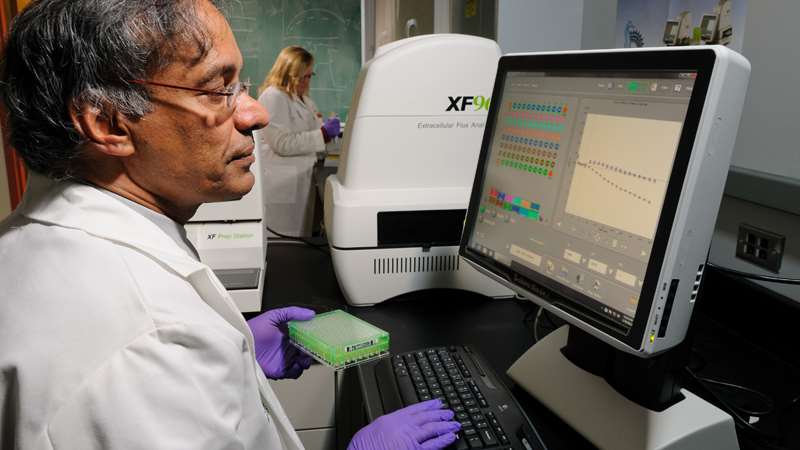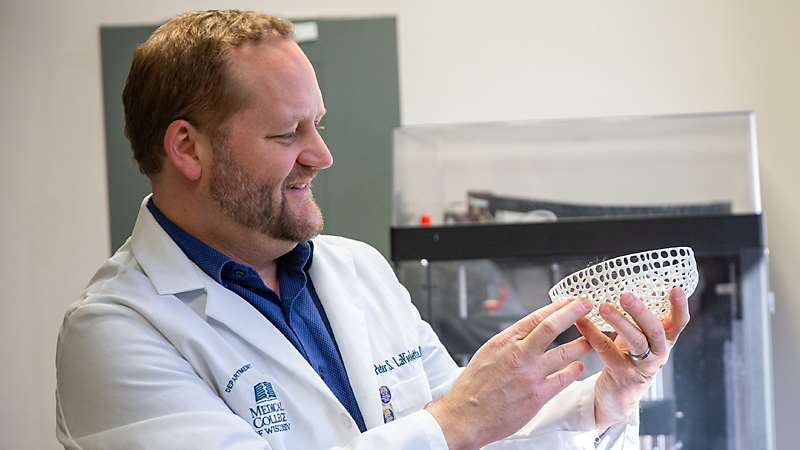Scheduling, Location, and Hours of Operation
Mass Spectrometry: Center for Cancer Discovery, N1130, Floor 1
Redox & Bioenergetics: Center for Cancer Discovery, N1130, Floor 1
Monday–Friday from 8 a.m.-5 p.m.
Services and Technologies
The TraMSR advances cancer research by identifying, quantifying, and imaging molecular metabolic profiles of cancer cells and tumors. Combining expertise in mass spectrometry and bioenergetics, preclinical imaging, and clinical trial response assessment using artificial intelligence (AI), TraMSR supports both preclinical research and patient monitoring in clinical trials.
iLab Requests; Funding Support
iLab Requests and Support
Funding Support
Investigators should first utilize all available funding resources (below). If funding support is still needed, contact the Shared Resource Director to discuss Cancer Center support.
- Grant Funding (internal or external)
- Cancer Center Pilot Grants
- Start-up Funding
- Departmental Support
Shared Resource Acknowledgement
View Shared Resource acknowledgement instructions. (PDF)
We Value Your Feedback
Director

Karin Hoffmeister, MD
Director, Translational Metabolomics Shared Resource
Technical Directors



Peter S. LaViolette, PhD, MS
Technical Director, Quantitative Clinical Imaging

Mass Spectrometry Staff Members



Quantitative Clinical Imaging Staff Members


Redox & Bioenergetics Staff Members

Notable Publications
Lysosomal enzyme binding to the cation-independent mannose 6-phosphate receptor is regulated allosterically by insulin-like growth factor 2. (Bohnsack RN, Misra SK, Liu J, Ishihara-Aoki M, Pereckas M, Aoki K, Ren G, Sharp JS, Dahms NM) Sci Rep 2024 Nov 06;14(1):26875. PMID: 39505925; PMCID: PMC11541866; DOI: 10.1038/s41598-024-75300-9; Scopus ID: 2-s2.0-85208688601
Glycosphingolipids and their impact on platelet activity in a murine model of fabry disease. (Kanack AJ, Prodoehl E, Ishihara-Aoki M, Aoki K, Dahms NM) Sci Rep 2024 Nov 27;14(1):29488. PMID: 39604471; PMCID: PMC11603304; DOI: 10.1038/s41598-024-80633-6; Scopus ID: 2-s2.0-85210527022
Radio-pathomic maps of glioblastoma identify phenotypes of non-enhancing tumor infiltration associated with bevacizumab treatment response. (Bobholz SA, Hoefs A, Hamburger J, Lowman AK, Winiarz A, Duenweg SR, Kyereme F, Connelly J, Coss D, Krucoff M, Banerjee A, LaViolette PS) J Neurooncol 2024 Apr;167(2):243. PMID: 38498261; PMCID: PMC11023959; DOI: 10.1007/s11060-024-04641-2; Scopus ID: 2-s2.0-85187929260
Regulation of immunomodulatory networks by Nrf2-activation in immune cells: Redox control and therapeutic potential in inflammatory diseases. (Pant T, Uche N, Juric M, Zielonka J, Bai X) Redox Biol 2024 Apr;70:103077. PMID: 38359749; PMCID: PMC10877431; DOI: 10.1016/j.redox.2024.103077; Scopus ID: 2-s2.0-85185554817
Noninvasive Autopsy-Validated Tumor Probability Maps Identify Glioma Invasion Beyond Contrast Enhancement. (Bobholz SA, Lowman AK, Connelly JM, Duenweg SR, Winiarz A, Nath B, Kyereme F, Brehler M, Bukowy J, Coss D, Lupo JM, Phillips JJ, Ellingson BM, Krucoff MO, Mueller WM, Banerjee A, LaViolette PS) Neurosurgery 2024 Mar 19. PMID: 38501824; DOI: 10.1227/neu.0000000000002898
Health position paper and redox perspectives - Disease burden by transportation noise. (Sørensen M, Pershagen G, Thacher JD, Lanki T, Wicki B, Röösli M, Vienneau D, Cantuaria ML, Schmidt JH, Aasvang GM, Al-Kindi S, Osborne MT, Wenzel P, Sastre J, Fleming I, Schulz R, Hahad O, Kuntic M, Zielonka J, Sies H, Grune T, Frenis K, Münzel T, Daiber A) Redox Biol 2024 Feb;69:102995. PMID: 38142584; PMCID: PMC10788624; DOI: 10.1016/j.redox.2023.102995; Scopus ID: 2-s2.0-85180606610
Quantitative Histomorphometric Features of Prostate Cancer Predict Patients Who Biochemically Recur Following Prostatectomy. (Duenweg SR, Brehler M, Lowman AK, Bobholz SA, Kyereme F, Winiarz A, Nath B, Iczkowski KA, Jacobsohn KM, LaViolette PS) Lab Invest 2023 Dec;103(12):100269. PMID: 37898290; PMCID: PMC10872376; DOI: 10.1016/j.labinv.2023.100269; Scopus ID: 2-s2.0-85181176849
T2-Weighted MRI Radiomic Features Predict Prostate Cancer Presence and Eventual Biochemical Recurrence. (Duenweg SR, Bobholz SA, Barrett MJ, Lowman AK, Winiarz A, Nath B, Stebbins M, Bukowy J, Iczkowski KA, Jacobsohn KM, Vincent-Sheldon S, LaViolette PS) Cancers (Basel) 2023 Sep 06;15(18). PMID: 37760407; PMCID: PMC10526331; DOI: 10.3390/cancers15184437; Scopus ID: 2-s2.0-85172781879
Carvedilol Phenocopies PGC-1α Overexpression to Alleviate Oxidative Stress, Mitochondrial Dysfunction and Prevent Doxorubicin-Induced Toxicity in Human iPSC-Derived Cardiomyocytes. (Uche N, Dai Q, Lai S, Kolander K, Thao M, Schibly E, Sendaydiego X, Zielonka J, Benjamin IJ) Antioxidants (Basel) 2023 Aug 09;12(8). PMID: 37627583; PMCID: PMC10451268; DOI: 10.3390/antiox12081585; Scopus ID: 2-s2.0-85169136890
Antiproliferative effects of mitochondria-targeted N-acetylcysteine and analogs in cancer cells. (Cheng G, Hardy M, Kalyanaraman B) Sci Rep 2023 May 04;13(1):7254. PMID: 37142668; PMCID: PMC10160116; DOI: 10.1038/s41598-023-34266-w; Scopus ID: 2-s2.0-85158068757
Developing small-diameter vascular grafts with human amniotic membrane: long-term evaluation of transplantation outcomes in a small animal model. (Wang B, Wang X, Kenneth A, Drena A, Pacheco A, Kalvin L, Ibrahim ES, Rossi PJ, Thatcher K, Lincoln J) Biofabrication 2023 Jan 30;15(2). PMID: 36626826; DOI: 10.1088/1758-5090/acb1da; Scopus ID: 2-s2.0-85147095444
Mitigation of gastrointestinal graft-versus-host disease with tocilizumab prophylaxis is accompanied by preservation of microbial diversity and attenuation of enterococcal domination. (Chhabra S, Szabo A, Clurman A, McShane K, Waters N, Eastwood D, Samanas L, Fei T, Armijo G, Abedin S, Longo W, Hari P, Hamadani M, Shah NN, Runaas L, Jerkins JH, Van den Brink M, Peled JU, Drobyski WR) Haematologica 2023 Jan 01;108(1):250-256. PMID: 36106394; PMCID: PMC9827178; DOI: 10.3324/haematol.2022.281309; Scopus ID: 2-s2.0-85145424654
Fluorinated triphenylphosphonium analogs improve cell selectivity and in vivo detection of mito-metformin. (AbuEid M, Keyes RF, McAllister D, Peterson F, Kadamberi IP, Sprague DJ, Chaluvally-Raghavan P, Smith BC, Dwinell MB) iScience 22 December 2022;25(12). DOI: 10.1016/j.isci.2022.105670; Scopus ID: 2-s2.0-85143723525
Corrigendum to ‘Ixazomib for chronic Graft-Versus-Host Disease prophylaxis following allogeneic hematopoietic cell transplantation.’ (Chhabra S, Visotcky A, Pasquini MC, Zhu F, Tang X, Zhang MJ, Thompson R, Abedin S, D'Souza A, Dhakal B, Drobyski WR, Fenske TS, Jerkins JH, Rizzo JD, Runaas L, Saber W, Shah NN, Shaw BE, Horowitz MM, Hari PN, Hamadani M) [Biology of Blood and Marrow Transplantation 26/10 (2020) 1876-1885, (S1083879120304146), (10.1016/j.bbmt.2020.07.005)] Transplantation and Cellular Therapy October 2022;28(10):717. PMID: 36202527; DOI: 10.1016/j.jtct.2021.01.005; Scopus ID: 2-s2.0-85101258094
Multi-Site Concordance of Diffusion-Weighted Imaging Quantification for Assessing Prostate Cancer Aggressiveness.(McGarry SD, Brehler M, Bukowy JD, Lowman AK, Bobholz SA, Duenweg SR, Banerjee A, Hurrell SL, Malyarenko D, Chenevert TL, Cao Y, Li Y, You D, Fedorov A, Bell LC, Quarles CC, Prah MA, Schmainda KM, Taouli B, LoCastro E, Mazaheri Y, Shukla-Dave A, Yankeelov TE, Hormuth DA 2nd, Madhuranthakam AJ, Hulsey K, Li K, Huang W, Huang W, Muzi M, Jacobs MA, Solaiyappan M, Hectors S, Antic T, Paner GP, Palangmonthip W, Jacobsohn K, Hohenwalter M, Duvnjak P, Griffin M, See W, Nevalainen MT, Iczkowski KA, LaViolette PS) J Magn Reson Imaging 2022 Jun;55(6):1745-1758. PMID: 34767682; PMCID: PMC9095769; DOI: 10.1002/jmri.27983; Scopus ID: 2-s2.0-85118887092
Prevention of Tumor Growth and Dissemination by In Situ Vaccination with Mitochondria-Targeted Atovaquone. (Huang M, Xiong D, Pan J, Zhang Q, Wang Y, Myers CR, Johnson BD, Hardy M, Kalyanaraman B, You M) Adv Sci (Weinh) 2022 Apr;9(12):e2101267. PMID: 35243806; PMCID: PMC9036031; Scopus ID: 2-s2.0-85125564839
Oncostatin M Receptor-Targeted Antibodies Suppress STAT3 Signaling and Inhibit Ovarian Cancer Growth. (Geethadevi A, Nair A, Parashar D, Ku Z, Xiong W, Deng H, Li Y, George J, McAllister DM, Sun Y, Kadamberi IP, Gupta P, Dwinell MB, Bradley WH, Rader JS, Rui H, Schwabe RF, Zhang N, Pradeep S, An Z, Chaluvally-Raghavan P) Cancer Res 2021 Oct 15;81(20):5336-5352. PMID: 34380633; PMCID: PMC8530981; Scopus ID: 2-s2.0-85116424540
Pertuzumab and trastuzumab for HER2-positive, metastatic biliary tract cancer (MyPathway): a multicentre, open-label, phase 2a, multiple basket study. (Javle M, Borad MJ, Azad NS, Kurzrock R, Abou-Alfa GK, George B, Hainsworth J, Meric-Bernstam F, Swanton C, Sweeney CJ, Friedman CF, Bose R, Spigel DR, Wang Y, Levy J, Schulze K, Cuchelkar V, Patel A, Burris H) Lancet Oncol 2021 Sep;22(9):1290-1300. PMID: 34339623; DOI: 10.1016/S1470-2045(21)00336-3; Scopus ID: 2-s2.0-85113412076
Nuclear PFKP promotes CXCR4-dependent infiltration by T cell acute lymphoblastic leukemia. (Gao X, Qin S, Wu Y, Chu C, Jiang B, Johnson RH, Kuang D, Zhang J, Wang X, Mehta A, Tew KD, Leone GW, Yu XZ, Wang H) J Clin Invest 2021 Aug 16;131(16). PMID: 34255748; PMCID: PMC8363288; Scopus ID: 2-s2.0-85113146308
WDR26 and MTF2 are therapeutic targets in multiple myeloma. (Sun F, Cheng Y, Riordan JD, Dupuy A, Dubois W, Pisano M, Dong J, Mock B, Zhan F, Hari P, Janz S) J Hematol Oncol 2021 Dec 07;14(1):203. PMID: 34876184; PMCID: PMC8650373; Scopus ID: 2-s2.0-85120899924
AMPK-deficiency forces metformin-challenged cancer cells to switch from carbohydrate metabolism to ketogenesis to support energy metabolism. (Palma FR, Ratti BA, Paviani V, Coelho DR, Miguel R, Danes JM, Zaichik SV, de Abreu AL, Silva SO, Chen Y, Silverstein RL, Karan U, Jones DP, Bonini MG) Oncogene 2021 Sep;40(36):5455-5467. PMID: 34290400; PMCID: PMC8669831; DOI: 10.1038/s41388-021-01943-x; Scopus ID: 2-s2.0-85110982210



